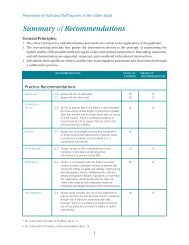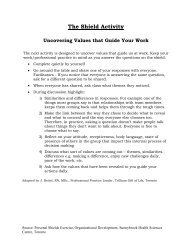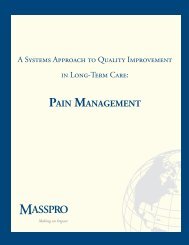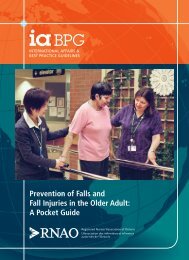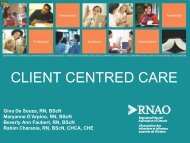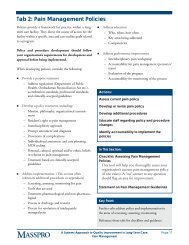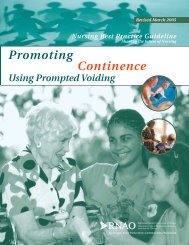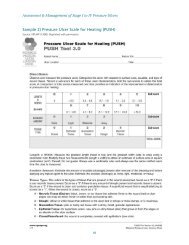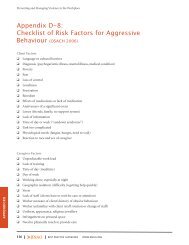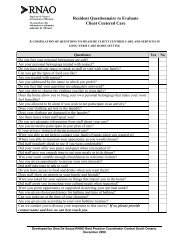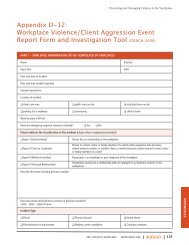Checklist for Development of a Care Plan - Long-Term Care Best ...
Checklist for Development of a Care Plan - Long-Term Care Best ...
Checklist for Development of a Care Plan - Long-Term Care Best ...
Create successful ePaper yourself
Turn your PDF publications into a flip-book with our unique Google optimized e-Paper software.
Tab 6: <strong>Care</strong> <strong>Plan</strong>ning <strong>for</strong> Pain<strong>Development</strong> <strong>of</strong> a <strong>Care</strong> <strong>Plan</strong>This section discusses the resident’s individualized careplan. In<strong>for</strong>mation obtained from screening, assessing andmonitoring the resident <strong>for</strong> pain (with use <strong>of</strong> a pain ratingscale) brings comprehensive in<strong>for</strong>mation to the careplanning team.The care planning team, together with the resident andfamily (if available and with the resident’s consent as appropriate)develop acceptable interventions and measurablegoals in managing the resident’s pain.Implementation <strong>of</strong> the care plan comes next. Ongoingmonitoring <strong>of</strong> the resident’s pain plan continues, leadingto in<strong>for</strong>mation that helps the team evaluate the effectiveness<strong>of</strong> the plan and the need <strong>for</strong> further adjustment tomaximize relief <strong>of</strong> pain.In This Section:<strong>Checklist</strong>: Developing Pain <strong>Care</strong> <strong>Plan</strong>sImportant components <strong>of</strong> a pain plan reviewed.Decision Tree <strong>for</strong> Pain <strong>Care</strong> ProcessesFlow Diagram: <strong>Development</strong> <strong>of</strong> a <strong>Plan</strong> <strong>of</strong> <strong>Care</strong><strong>for</strong> a ResidentKey elements <strong>for</strong> care planning are citedMDS Coding Instructions For QualityMeasuresReminders:• Ensure that care plan approaches adhere toaccepted clinical guidelines and the facility'spolicies and procedures• Follow the facility’s process <strong>for</strong> the resolution<strong>of</strong> inadequately managed pain• Ensure that the resident's pain plan iscommunicated during transfer and discharge• Ensure that the resident's pain is communicatedto the MDS CoordinatorA Systems Approach to Quality Improvement in <strong>Long</strong>-<strong>Term</strong> <strong>Care</strong>:Pain ManagementPage 82
<strong>Care</strong> <strong>Plan</strong>ning <strong>for</strong> PainKey <strong>Care</strong> <strong>Plan</strong> ApproachesPharmacologic Management• Individualize the regime to the resident.• Use the simplest dosage schedule and least invasivetreatment modalities first (oral medicationvs. intravenous medications). Adjust doses <strong>of</strong>medications to individual resident responses.• Pharmacologic management <strong>of</strong> mild-to-moderatepain may include a non-steriodal anti-inflammatorydrug (NSAID) or acetaminophen unless they arecontraindicated. Each has maximum daily doselimits.• When pain persists or increases, an opioid isrecommended.• Increase the opioid dose <strong>for</strong> treatment <strong>of</strong> persistent,or moderate-to-severe pain.• For persistent pain, it is recommended thatmedication be administered around the clock withadditional "as needed doses" <strong>for</strong> pain that reoccursbetween routine dosing.• Oral route is the preferred route <strong>of</strong> analgesicadministration; if the resident cannot takemedicaitons orally, then rectal, transdermal,subcutaneous, or intravenous routes may beconsidered. Avoid intramuscular (IM) injections <strong>for</strong>pain control.• Monitor <strong>for</strong> medication side effects.• Since constipation is an expected problem with theuse <strong>of</strong> opioid pain medication, treat constipationprophylactically and monitor it constantly. As<strong>of</strong>tener and stimulant together are usually requiredto manage opioid-induced constipation.• When a resident is transferred from one setting toanother, communication about pain managementhistory is necessary.• Medication not recommended:– Indomethacin, piroxicam, tolmentin, mecl<strong>of</strong>enamate_ Propoxyphene, rneperidin, Pentazocine,butorphanolAdjuvant Drugs• Corticosteroids: Provide a range <strong>of</strong> effects includinganti-inflammatory, anti-emetic activity, appetitestimulant, and mood elevation.• Anticonvulsants: Used to manage neuropathic pain,especially when the resident reports burning pain.• Antidepressants: Tricyclic antidepressants andSSNRI antidepressants are useful as adjuvantanalgesics in the management <strong>of</strong> neuropathic pain,as well as potentially enhancing opioid analgesia,and elevating mood. (Monitor carefully <strong>for</strong>anticholinergic adverse effects.) SSRI antidepressantshave little pain relieving qualities and are not <strong>of</strong>tenused <strong>for</strong> pain management.Non-Pharmacologic Management –PhysicalShould be used with or without medications, but shouldnot be used in place <strong>of</strong> medications.• Cutaneous stimulation techniques- Hot/cold- Massage- Pressure or vibration• Exercise• Immobilization• Transcutaneous electrical nerve stimulation (TENS)• Acupuncture• Assistive devicesPsychosocial Interventions• Relaxation and imagery• Distraction and reframing• Psychotherapy• Hypnosis• Reiki• Peer support groups• Pastoral counselingA Systems Approach to Quality Improvement in <strong>Long</strong>-<strong>Term</strong> <strong>Care</strong>:Pain ManagementPage 83
<strong>Care</strong> <strong>Plan</strong>ning <strong>for</strong> PainNon-Pharmacologic Interventions –Invasive• Radiation therapy• Nerve blocks• Neurosurgery/surgeryEducationResident and family education including:• The many misconceptions regarding pain and itstreatment• Medications• Non-pharmacological management (physical andinvasive)• Psychosocial interventionsRoutine <strong>Care</strong>• Positioning• Frequent oral care• Prevention <strong>of</strong> pressure ulcers and contractures• One-on-one visits• Emotional support to the resident and family• Review advanced directivesReassessment <strong>of</strong> Pain• It is recommended that on a daily basis, theresident's response to pain medication be monitoredwithin an hour <strong>of</strong> receiving the medication• If the resident is complaining <strong>of</strong> worsening pain ornew pain, it is recommended that a comprehensiveassessment <strong>of</strong> pain be completed and a plan <strong>of</strong> caredeveloped or revised• Reassessment should occur at regular intervals afterstarting the plan (quarterly and with significantchanges or unrelieved pain)A Systems Approach to Quality Improvement in <strong>Long</strong>-<strong>Term</strong> <strong>Care</strong>:Pain ManagementPage 84
<strong>Checklist</strong>: Developing Pain <strong>Care</strong> <strong>Plan</strong>sDoes your facility have a process <strong>for</strong> developing and implementing a care plan <strong>for</strong> pain <strong>for</strong>residents who have been found to have pain upon screening?______ No. If no, this is an area <strong>for</strong> improvement. Use this checklist and the QualityImprovement Worksheets to guide your team in implementing a process <strong>for</strong> developing acare plan <strong>for</strong> pain.______This is an area we are working on. Our target date <strong>for</strong> implementing a process <strong>for</strong>developing a care plan <strong>for</strong> pain is:__________. If needed, use the Quality ImprovementWorksheets to guide your improvement process.______Yes. Please continue to the questions below.Does the plan <strong>of</strong> care <strong>for</strong> pain address all the areas below?1. Does the care plan <strong>for</strong> pain include a pain control goal as defined by theresident/caregiver/family member?2. Does the care plan include education <strong>of</strong> the resident and family related to theseareas <strong>of</strong> pain management:Goal <strong>of</strong> therapySide effects (e.g., drowsiness)ConstipationOverall treatment plan3. For residents with daily pain, does the plan provide <strong>for</strong> medication on a regularschedule (e.g., around the clock), not just PRN?4. Does the plan provide <strong>for</strong> medication use by mouth if at all possible?5. Does the plan provide <strong>for</strong> using non-pharmacological approaches to painmanagement (e.g., massage, music, aromatherapy, ice or heat, etc.)?6. Does the plan provide <strong>for</strong> keeping the resident as mobile as possible?7. Does the plan address positioning and proper movement to minimize theresident’s pain?8. Does the plan provide <strong>for</strong> a regular assessment (e.g., monitoring) <strong>of</strong> residents’response to pain medications?9. Does the plan outline when the monitoring reassessment <strong>of</strong> resident’s pain will becompleted?If any <strong>of</strong> the above elements in your process <strong>for</strong> care planning <strong>for</strong> pain are missing:YesNo• Choose one element to focus your quality improvement ef<strong>for</strong>t first.• Start with the Quality Improvement Worksheet A: Identifying Areas <strong>for</strong> Improvement to collect datato investigate further.• Follow the Quality Improvement Worksheets to implement missing element(s) and monitor regularlyto determine whether implementation is successful.If none <strong>of</strong> the above elements are missing from your facility’s process <strong>for</strong> care, please continue to anotherchecklist.This material was developed by the QIO program from CMS’ NHQI and is intended as general in<strong>for</strong>mation. Anyindividual using the material must consider the possibility <strong>of</strong> human error, changes in medical sciences, and theneed to use clinical judgment in each specific case.





